Singapore Shuffle
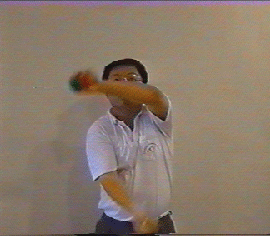
Loh Koah Fong demonstrates the Singapore Shuffle
Notice that the green ball flies from hand to hand and is always thrown as one of the two ball multiplex throws.
The yellow ball is only thrown and caught by the right hand. One throw is part of a right hand multiplex (with the green ball). The other throw is with the yellow ball by itself.
The orange ball is only thrown and caught by the left hand. One throw alone and one throw as part of a two ball multiplex (with the green ball).
------------
Loh Koah Fong is a systems analyst working in Nanyang Technological University. He was inspired by the Georgian Shuffle at Colin Wright's site and was keen to develop a double sided version of the trick.
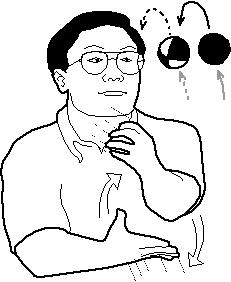
Loh Koah Fong from Singapore learned the Georgian Shuffle and balanced the pattern so both hands have the same amount and types of throws. Keeping with the geographical tradition, he calls this new pattern the Singapore Shuffle. It will be very helpful to be able to juggle the Georgian Shuffle both left and right handed for this pattern.
The Singapore Shuffle has a standard right, left, right, left throwing sequence. However, it will be easier for most people to think of this as two sets of three, right (multiplex), left , right and left (multiplex), right, left. If you think of the first set of three as the right hand side, the second set of three is the left hand side.
The flight patterns of each of the three balls are unique. As with the Georgian Shuffle, begin with the striped ball and the black ball in the right hand and the white ball in the left hand. The black ball is always thrown and caught only by the right hand. The white ball is always thrown and caught only by the left hand. Both the white ball and the black ball alternate between being thrown once alone and once as the first ball in a multiplex throw of two balls. The striped ball alternates between both hands. The striped ball is always thrown as the second ball in the two ball multiplex throws.
Every throw in the pattern is from an underarm crossed arms position. A good warm up is to juggle three balls and cross your arm underneath the other every time before you throw. The difference between this warm up exercise and the Singapore Shuffle is that the first and fourth throws of the Singapore Shuffle are multiplex throws. These multiplex throws, and dealing with the split catches, is what makes this pattern so challenging.
The first two throws of the Singapore Shuffle are the same as the Georgian Shuffle. If you have learned the Georgian Shuffle both right and left handed, you are well on the way to learning the Singapore Shuffle. The difference between the two patterns comes after you make the second throw, the white ball. In the Georgian Shuffle the right hand catches the white ball. In the Singapore Shuffle the left hand catches the white ball.
Here is a quick review of the first two throws. The right hand is crossed under the left and multiplex throws the black and the striped ball with one toss. The black ball is caught in the right hand while the striped ball migrates over to the left hand.
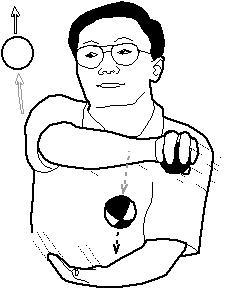
The left arm crosses under the right and the left hand throws the white ball to itself. The right hand catches the black ball and then the left hand catches the striped ball.
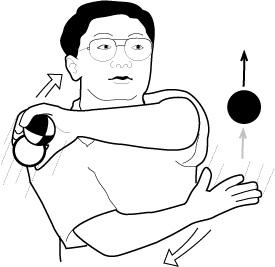
The right arm crosses under the left and the right hand throws the black ball to itself. You have just completed the first set of three throws, right, left, right, and are halfway through the pattern.
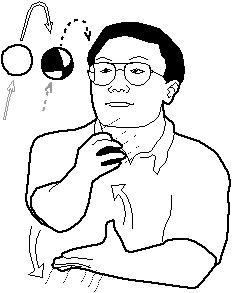
Now comes the second set of three throws, left, right, left. The striped ball is already in the left hand. The left hand also catches the white ball, while it is crossed over the right arm. The left arm crosses under the right arm and then the left hand multiplex throws both the white ball and the striped ball.
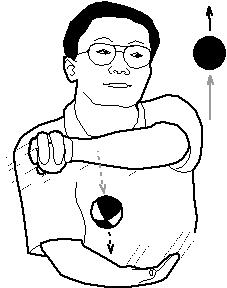
The right arm crosses under the left and throws a solitary black ball to itself. The left hand catches the white ball and the right hand catches the striped ball.
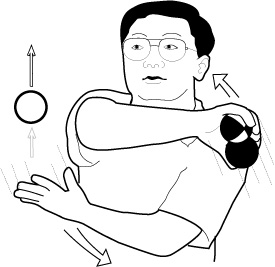
The left arm crosses under the right and throws a solitary white ball to itself. Add the black ball to the striped ball by catching the black ball in your right hand.
Congratulations, you have just completed all six throws. Cross the right arm under the left and throw both the black ball and the striped ball to continue the pattern.
Jugglers who don't mind talking to themselves while learning may want to say "right, left, right," followed by "left, right, left." More precisely, you could say "right multiplex, left, right, left multiplex, right, left," over and over.
It may be helpful to work on beginning this pattern with the left hand. Place the striped ball and the white ball in the left hand. Cross your left arm under the right arm and begin with a multiplex throw from the left hand.
The Extended Singapore Shuffle
Like most jugglers, Loh Koah Fong enjoys making things more difficult than they already are. You can extend the Singapore Shuffle so that all balls fly to all positions.
The trick is to catch the two balls in one hand with claw catches, and turn your wrist over when you make the throw. This switches the positions of the balls in the hand. Instead of a LIFO method, you now have a FIFO (first in, first out) release. In this extended version, it takes eighteen throws for the balls to fly through all the positions and return to the beginning configuration.

- Home
- About
- Ball Juggling
- Cigar Boxes
- Club Juggling
- Club Swinging
- Comedy Writing
- Cup Stacking
- Devil Sticks
- Diabolo
- Diabolo Postcards
- Dice Stacking
- Hat Manipulation
- Lasso
- Miscellanous Juggling
- Parachute Games
- Poi Swinging
- Ring Juggling
- Shaker Cups
- Skill Games
- Staff
- Tennis Balls and Can
- New Games Foundation
- Ordering and Shipping
- Contact Information
- Peeps (photos of birds and stuff)
- Personal Thoughts
- Workshops
- Links
- Questions? Comments? Feedback?